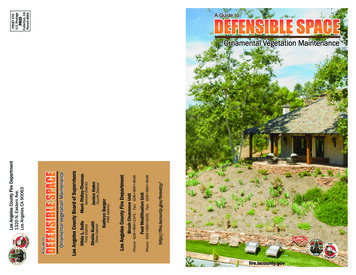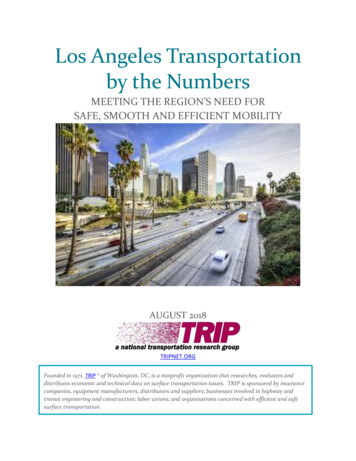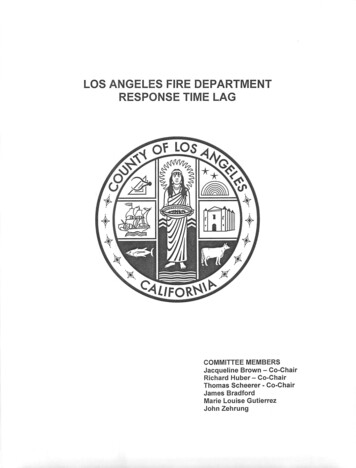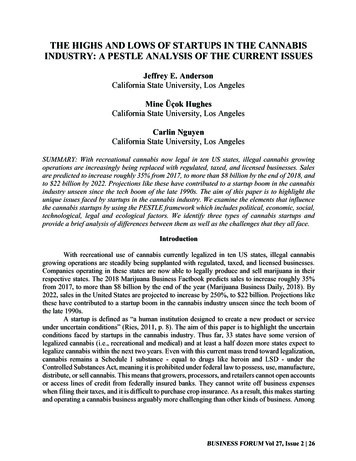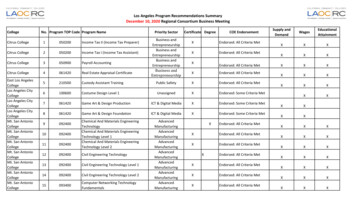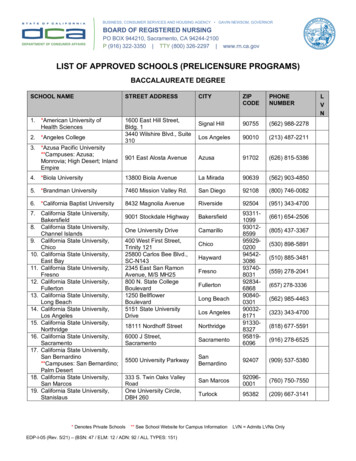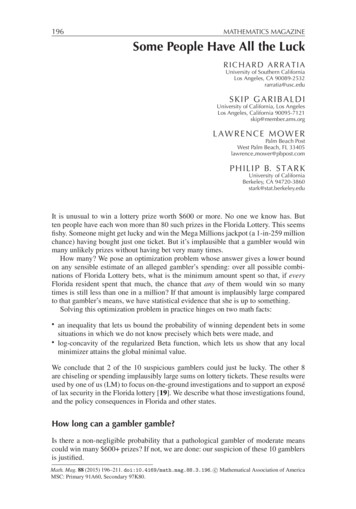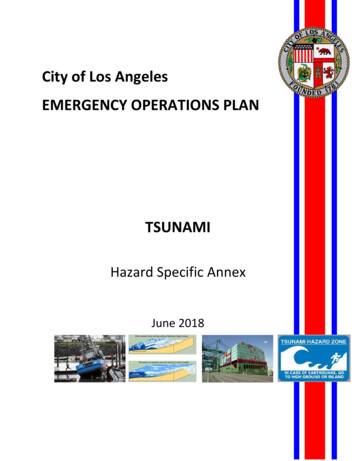
Transcription
City of Los AngelesEMERGENCY OPERATIONS PLANTSUNAMIHazard Specific AnnexJune 2018
TABLE OF CONTENTSANNEX DEVELOPMENT AND MAINTENANCE . 1APPROVAL AND IMPLEMENTATION . 2RECORD OF CHANGES . 3CITY EMERGENCY OPERATIONS PLAN/ANNEX CROSS REFERENCE . 4BACKGROUND . 5I. PURPOSE, SCOPE, SITUATION AND ASSUMPTIONS . 7A. Purpose . 7B. Scope . 8C. Situation Overview . 8D. Assumptions . 10II. CONCEPT OF OPERATIONS . 12A. Terminology . 12B. Pre-Event . 14C. Activation of Plan . 18D. Documentation and Time-Keeping . 18III. ORGANIZATION AND ASSIGNMENT OF RESPONSIBILITIES . 19A. City of Los Angeles . 19IV. DIRECTION, CONTROL AND COORDINATION . 49V. ADMINISTRATION, FINANCE AND LOGISTICS . 50VI. AGREEMENTS AND UNDERSTANDINGS . 51VII. AUTHORITIES AND REFERENCES . 52Attachment A: Acronyms . 54Attachment B: Tsunami Inundation Area Maps . 56Attachment C: Tsunami Evacuation Maps . 59
Attachment D: Tsunami Evacuation Routes . 70Attachment E: Schools in Hazard Zone . 74Attachment F: ALERT and NOTIFICATION of Tsunami . 75Attachment G: Sample Warning Center Tsunami Alert . 79Attachment H: Sample EDIS Tsunami Information Bulletin . 80Attachment I: Sample EDIS Tsunami Watch/Warning . 81Attachment J: Sample BRIEFING FORMAT . 82Attachment K: Sample TSUNAMI WATCH Briefing . 83Attachment L: Sample TSUNAMI WARNING Briefing . 84Attachment M: Sample TSUNAMI CANCELLATION Briefing . 85Attachment N: Sample MEDIA RELEASE MESSAGES . 86Attachment O: Sample EVACUATION ORDERS . 87Attachment P: Other Agencies . 89
ANNEX DEVELOPMENT AND MAINTENANCEThis Annex is developed in support of the City of Los Angeles Emergency Operations Plan (EOP)to facilitate response during tsunami incidents.This Annex is developed in cooperation and with input from the City departments with primaryresponse or support activities, as well as input from appropriate non-City agencies withidentified activities related to tsunamis.This Annex is developed to describe the overall citywide response function and capabilities, andis to be used by each department identified within this Annex to develop their ownstandardized operating procedures (SOPs) specifically for their department to direct tacticaloperations. When developing SOPs, each department is to take into consideration how all ofthe activities identified in this plan directly related to their own department, as well as howthose activities interact with, support, or require support from other departments identifiedwithin this plan. Departments must ensure that their SOPs are inclusive of planning for peoplewith disabilities and others with access and functional needs. If, at any time, any departmentidentifies a conflict in how their field response or support activities are performed incomparison to what is described in this Annex, and/or identifies a conflict between their listedactivities within this Annex and how they relate to or support another department’s listedactivities, such conflict is to be immediately reported to the Emergency ManagementDepartment – Planning Division.If, at any time, a department, agency, or stakeholder to this plan changes, develops, or amendsany policy, procedure, or operation that will change or affect the contents of this plan, thatentity is to immediately notify the Emergency Management Department – Planning Division.This Annex is to be corrected immediately upon notification or observation of any operationalerrors or conflicts. Such corrections are to be reflected within the Record of Changes.Every other year, a formal review of this Annex will be conducted by departments and agenciesthat are identified within the Annex, as well as any other departments or agencies that mayneed to be part of the review process. The Emergency Management Department – PlanningDivision will lead such an effort. Upon completion of such formal review, all corrections to theplan will be reflected within the Record of Changes.1
APPROVAL AND IMPLEMENTATIONThis document is a Hazard Specific Annex to the City of Los Angeles Emergency EOP. It serves aseither a stand-alone plan or companion document to an applicable Hazard Specific ResponseAnnex to the EOP. The Annex was developed with input from all applicable City of Los Angelesdepartments and allied stakeholders. Upon completion, it is reviewed by the City’s EmergencyManagement Committee (EMC). When approved by the EMC, it presents the document to theEmergency Operations Board (EOB) with a recommendation for approval. Upon review andapproval by the EOB, the document goes to the Mayor of the City of Los Angeles with arecommendation to approve and forward to the City Council for adoption.Upon formal approval by the Mayor and adoption by the City Council, this document becomesan official Annex to the City of Los Angeles EOP.This Annex was developed with input from all applicable Los Angeles City Departments. ThisAnnex is compliant with the Federal Emergency Management Agency (FEMA) ComprehensivePreparedness Guide (CPG) 101, Developing and Maintaining Emergency Operations Plans,Version 2.0 (CPG 101 V.2)1.1Developing and Maintaining Emergency Operations Plans. Comprehensive Preparedness Guide (CPG) 101, version2.0 ed. (n.p.: U.S. Department of Homeland Security, Federal Emergency Management Agency, 2010).2
RECORD OF CHANGESEach revision or correction to this Annex must be recorded. The record contains the date,location, and brief description of change, as well as who requested or performed such change.Table 1: Record of ChangesDateSection/PageDescription of ChangeChanged By4-4-18All2 Year Revision DueLarry Meyerhofer1-28-19AllReview for inclusion of new content and mapsTayler Lorence3
CITY EMERGENCY OPERATIONS PLAN/ANNEX CROSS REFERENCEDuring the response to this identified hazard, the following functional support shall be used asdeemed necessary: Throughout this document, where public information and communication with the public isreferenced, see the Emergency Public Information Annex. Where internal communications systems is referenced, see the Communications Annex. Where early warning and notification is referenced, see the Early Warning and NotificationAnnex. Where sheltering, mass care, mass feeding and the provision of functional needs supportservices (FNSS) is referenced, see the Mass Care and Sheltering Annex; ResettlementProcessing Center Annex; and Logistics Annex. Where reference is made to evacuations, see the Evacuation Annex. Where reference is made to Federal, State, Local or Non-Governmental Organizationsproviding recovery information, see the Local Assistance Center Annex and RecoveryAnnex. Where reference is made to response and restoration of critical infrastructure, see theCritical Infrastructure Annex. Hazard specific annexes include the Earthquake Annex, Adverse Weather Annex, BrushfireAnnex, Urban Flooding Annex, Off-Airport Major Aircraft Response Annex, CivilDisturbance Annex, Terrorism Prevention & Protection Annex and CBRN Annex (includingthe Chemical, Biological, Radiological, and Nuclear Appendixes). All actions related to fulfilling the purpose of this Annex will adhere to the City of LosAngeles Citywide American with Disabilities Act (ADA) guides, documents, and checklists. Where City departments have tasks assigned relative to this Annex, please refer to thatspecific department’s Standard Operating Procedures.4
BACKGROUNDWhile historic and geologic evidence suggests the threat of a tsunami is greater in Alaska,Hawaii, and the northern coastal areas of California, there is still potential for a tsunami toimpact Southern California. Within the City of Los Angeles, areas of West Los Angeles, PacificPalisades, Venice, Playa Del Rey, and San Pedro (collectively referred to as the Los Angelescoastal areas) could be directly impacted by a tsunami event.A tsunami is a series of ocean seismic waves of extremely long length generated byearthquakes, volcanic eruptions, massive undersea landslides, or any other disturbance thatdisplaces a large water mass from its equilibrium position. As a distant tsunami crosses thedeep ocean the wave may be a hundred miles in length and only a few feet in height. Tsunamismay reach speeds of 600 miles per hour in deep water. Tsunamis are typically classified aseither local or distant. These two types of tsunamis have different implications forcomprehensive planning and evacuation warning.Distant tsunamis are the most common type of tsunami observed along the Pacific Coast of theUnited States. The time required for a distant tsunami to reach the Hawaiian and mainlandcoasts will vary between 5 ½ to 18 hours, provided the tsunami place of origin. The effects of adistant tsunami on the City of Los Angeles coastal area may be negligible or severe dependingupon the magnitude of the tsunami, its source distance, and the direction of its approach.Local tsunamis usually result from earthquakes occurring off nearby coasts. In SouthernCalifornia, large offshore or coastal fault movements could cause large submarine landslidesalong steep and unstable slopes of the Continental Shelf edge and offshore borderland ridges.The travel time of a local tsunami, from the source to coastal communities, is likely to bebetween five and 30 minutes. A local tsunami may require an earthquake response and theimmediate need to evacuate from inundation areas to higher ground.Several major earthquake faults are located off the California coast. While none of these arethought capable of a "great" earthquake of a magnitude of 8.0 or more, several could generatequakes in the 6.0 range. Such a quake could generate a local tsunami, especially if it involvesmajor uplift of the undersea earth surface as seen in the Northridge earthquake.In 20092, a tsunami inundation reassessment of California coastal areas was conducted in ajoint effort by the California Governor's Office of Emergency Services, the University ofSouthern California, and the California Geological Survey. This reassessment resulted in thedevelopment of tsunami inundation maps, indicating inundation areas along the Californiacoast, including the City of Los Angeles coastal areas. Tsunami inundation maps are critical inthe development of tsunami evacuation plans, evacuation routes, sign location, and identifyingSafe Refuge Centers as well as focused community outreach and educational programs,including detailed brochures. This Annex contains the inundation zone maps and tsunami2Los Angeles County Tsunami Inundation Maps.http://www.conservation.ca.gov/cgs/geologic hazards/Tsunami/Inundation Maps/LosAngeles5
evacuation maps based on the 2009 study (Attachment C: Tsunami Inundation Area Maps andAttachment D: Evacuation Route Maps).Any type of tsunami on the Los Angeles coastal areas would be most notable in the Venice,West Los Angeles, San Pedro and the Los Angeles Harbor areas. Continued development in theareas exposed to coastal inundation has increased the risk of property damage and loss of lifefrom future tsunamis. Historic and geologic evidence suggest the threat of tsunami is greater inAlaska, Hawaii and the northern coastal areas of California; however, there is evidence ofpotential impacts to Southern California.Additional detailed hazard analysis information regarding tsunami incidents in the City of LosAngeles can be found in the 2017 Local Hazard Mitigation Plan, Section 12.6
I. PURPOSE, SCOPE, SITUATION AND ASSUMPTIONSA. PurposeThis Annex details governmental responsibilities for the managed and communicatedresponse to a tsunami event. This Annex can be used in conjunction with other annexesand plans designed for the protection of the population. Organizations, operationalconcepts, responsibilities, and procedures described in this annex are applicable to alllocations and to all agencies, organizations, and personnel with responsibilities relatedto tsunami response.A tsunami event, occurring in any of the Los Angeles coastal areas, has the potential tocause flooding, fire, disruption of public utilities, property damage, and personal injury.The purpose of this Annex is to provide direction and guidance to the City departmentsand agencies in responding to significant incidents involving a local or distant tsunamithat would exceed the scope of incidents managed at the field level.The Tsunami Annex has been developed to meet the following objectives: Provide a concept of operations and identify roles and responsibilities for eachappropriate department within the City of Los Angeles;Define communication, coordination and evacuation procedures for rapidnotification and response of City departments, stakeholders, and the public inthe event of a tsunami related emergency;Identify Los Angeles coastal area tsunami inundation areas as well as associatedevacuation routes and Safe Refuge Centers;Define City department’s evacuation responsibilities related to critical facilities,including public schools and fire stations, within the inundation areas;Identify actions that can realistically be accomplished within a few hours to a fewdays to mitigate any adverse impact;Ensure consistency and continuity with Federal, State of California, the LosAngeles County Operational Area, and other local governments' emergencyresponse plans and operations; andEnsure consistency with Federal and State laws pertaining to emergencymanagement procedures relating to people with disabilities and others withaccess and functional needs.Management of a significant incident such as a tsunami is a critical function performedby members of different responding departments and agencies. In addition to thisAnnex, it is vital for all personnel to be familiar with their own department's emergencyplan, as well as those of assisting agencies. All emergency plans of City departments thathave responsibilities during a tsunami occurrence should delineate that department’sresponsibilities during such an event.7
B. ScopeThis Annex is applicable to City departments with Emergency Operations Organization(EOO) responsibilities and essential resources. Of particular importance to this plan are: City departments with emergency public safety functionsCity departments that primarily support departments with public safetyfunctionsCity departments with evacuation and sheltering functionsCity departments with public notification functionsThe City departments identified in this plan have distinct roles and responsibilities as itrelates to a tsunami emergency response. These departments include: Department of Aging (Aging)Department of Animal Services (Animal Services)Department on Disability (DOD)Emergency Management Department (EMD)Los Angeles Fire Department (LAFD)Port of Los Angeles (POLA)Los Angeles Police Department (LAPD)Department of Recreation and Parks (RAP)Los Angeles Department of Transportation (LADOT)C. Situation Overview1. CharacteristicsLocationThe City of Los Angeles covers 498 square miles with approximately 468 squaremiles of land (214 square miles of which are hills and mountains) and approximately29 square miles of water. The San Gabriel and Santa Susana Mountains bound theCity on the north and the Santa Monica Mountains extend across the middle of theCity. The Palos Verdes Hills and Pacific Ocean bound the City on the south and west.DemographicsAccording to the California Department of Demographic Research Unit’s “E-1Population Estimates for Cities, Counties, and the State3”, the 2016 populationestimate for the City of Los Angeles is 4,030,904. This breaks down to approximately8094 persons per square mile.The City of Los Angeles is one of the most diverse cities in the world. Angelinosspeak nearly 200 languages and are part of many different religious and belief3California Department of Finance, E-1 Population Estimates for Cities, Counties, and the State, January 1, 2015and 20168
systems. Community members who live, work, and play in Los Angeles includepeople with disabilities and others with access and functional needs.This plan will use the phrase people with disabilities and others with access andfunctional needs to describe both those that meet the definition of disability as wellas people who may or may not meet the definitions of civil rights laws or some ofthe 60 plus diverse definitions of disability4. The definitions for people withdisabilities as well as others with access and functional needs are provided below:People with Disabilities“Disability” in this context is a legal term rather than a medical one. It refers to afederally protected class under the 1990 ADA. Nationally, people with disabilitiesmake up about 20% of the population. To be in compliance with the law, emergencymanagers must apply the concepts of accessibility, inclusion, and nondiscriminationin providing services to the general public which includes communication of publicinformation and warnings, transportation, mass care and sheltering, andevacuations.Others with Access and Functional Needs“Others with Access and Functional Needs” is a broad definition that includesanyone who might have additional needs before, during, or after a disaster inaccessing services. This includes individuals that may or may not meet thedefinitions of disability under existing civil rights laws, such as people with limited orno English language proficiency, individuals that are institutionalized, women in lateterm pregnancy, or those with limited or no access to transportation. With thisbroader definition, about 50% of the population is considered to have an access orfunctional need. Anyone with a disability has an access and functional need, but noteveryone with an access and functional need has a disability.2. VulnerabilitiesThe City of Los Angeles has multiple, accessible, redundant warning and notificationsystems that it will utilize to reach the public for warnings, notification, and support. Theprimary mode of notification will be the Everbridge application. Other modes willinclude news releases and public service announcements to the media and directlythrough social media platforms. Factors to consider are specifics of the disaster,population density, and terrain in affected areas of Los Angeles. In some instances, theconsequences of a disaster along with terrain and the geographical area may impact theeffectiveness of notification systems.The City of Los Angeles recognizes that disasters may exhaust local resources. The Citycontinues to develop, update and/or maintain memorandum of understandings(MOU’s), memorandums of agreement (MOA’s), and contract amendments with privatevendors to increase response capability and available resources. In addition, the City of4Los Angeles Department of Public Health, “Adult Disability in Los Angeles County.” LA Health. Sept. 20069
Los Angeles’ Business Operations Center (BOC) maintains communication channels withthe private sector who may provide donations in an emergency.Due to the population density and terrain of the City of Los Angeles, the City recognizesthat, despite a good faith effort, it may not have the capabilities or resources to reachevery individual in terms of public warnings, notification and/or support.D. AssumptionsThis Annex was created to integrate the concepts and structure defined by the NationalIncident Management System (NIMS), the California Standardized EmergencyManagement system (SEMS), and the National Incident Command System (ICS). All City, State, and federal processes, procedures, and protocols reflected orreferenced in this document were current as of the date of approval of thisAnnex. Before implementing this Annex, confirm that the processes,procedures, and protocols are unchanged. If necessary, before implementing,modify the Annex to reflect updated processes, procedures, and protocols.Only departments that have a response role or a role closely supporting theresponse to a tsunami event will be included in this plan. The departmental roleslisted are limited to those applicable to the event.In any disaster, primary consideration is given to the preservation of life thenincident stabilization, and property preservation. Additionally, time and effortmust be given to providing critical life-sustaining needs.In a catastrophic incident, damage control and disaster relief will be requiredfrom the State and Federal government, other local governments and privateorganizations.The City Emergency Operations Center (EOC) may or may not be activated insupport of an event. EOC activation will be determined based on the scope andscale of the event.Electronic communications utilizing information technology systems will becompliant with Section 508 of the Rehabilitation Act.All printed public education material produced to support this Annex fordistribution to the general public shall be available in accessible formats.Many residential, commercial and institutional structures could be damaged;requiring a large Urban Search & Rescue/Heavy Rescue mobilization.Residents could be displaced; requiring shelter and social services needs.Sheltering activities could be short term or long term depending on the severityof the incident.Vital infrastructure such as potable water supplies, electrical power, natural gasand sewer services could be compromised. Re-establishment of these vitalresources will be critical.Transportation infrastructure could be damaged and in limited operation. Vitalvehicle and rail corridors could be damaged and impassible. Re-establishment oftransportation infrastructure will be critical.10
Communications infrastructure could be damaged; causing disruption in landline telephone, cellular telephone, radio, microwave, computer and othercommunication services. Re-establishment of communications infrastructurewill be critical.Hazardous materials incidents could be widespread in the inundation areas,including the Port of Los Angeles.Shipping Terminal Operations could be suspended or shut down.Bridges could be unusable, creating an area of isolation.Cargo container trucks could be stranded and sheltering could be required forthe drivers, the shore workers and maritime crews that work in the Port.Evacuation of federal prisoners and employees from Terminal Island could beaffected requiring additional assistance from City departments.11
II. CONCEPT OF OPERATIONSA. TerminologyAmplitude: The rise above or drop below the ambient water level as read on a tide gauge.Arrival Time: Time of onset, usually of the first wave of the tsunami, at a particular ans,seas,etc.Bore: Traveling wave with an abrupt vertical front or wall of water. Under certainconditions, the leading edge of a tsunami wave may form a bore as it approaches and runsonshore. A bore may also be formed when a tsunami wave enters a river channel, and maytravel upstream penetrating to a greater distance inland than the general inundation.CREST: Consolidated Reporting of Earthquakes and Tsunamis. A project funded through theTsunami Hazard Mitigation Federal/State Working Group to upgrade regional seismicnetworks in Alaska, Washington, Oregon, California, and Hawaii and to provide real-timeseismic information from these networks and the United States National Seismic Networkto the tsunami warning centers.Estimated Time of Arrival (ETA): Computed arrival time of the first tsunami wave at coastalcommunities after a specific earthquake has occurred.First Motion: Initial motion of the first wave. A rise in the water level is denoted by R, a fallby F.Free Field Offshore Profile: A profile of the wave measured far enough offshore so that it fects.Harbor Resonance: The continued reflection and interference of waves from the edge of aharbor or narrow bay. This interference can cause amplification of the wave heights andextend the duration of wave activity from a tsunami.Horizontal Inundation Distance: The distance that a tsunami wave penetrates onto theshore. Measured horizontally from the mean sea level position of the water's edge, it isusually measured as the maximum distance for a particular segment of the coast.Inundation: The depth, relative to a stated reference level, to which a particular location iscovered by water.Inundation Area: An area that is flooded with water.Inundation Line (limit): The inland limit of wetting, measured horizontally from the edge ofthe coast, defined by sea level.12
Leading-Depression Wave: Initial tsunami wave is a trough, causing a drawdown of waterlevel.Leading-Positive Wave: Initial tsunami wave is a crest, causing a rise in water level, alsocalled a leading-elevation wave.Local/Regional Tsunami: Source of the tsunami is within 1000 kilometers of the area ofinterest. Local or near-field tsunami has a very short travel time (30 minutes or less); midfield or regional tsunami waves have travel times on the order of 30 minutes to 2 hours.Note: "Local" tsunami is sometimes used to refer to a tsunami of landslide origin.Maremoto: Spanish term for tsunami.Marigram: Tide gauge recording showing wave height as a function of time.Marigraph: The instrument which records wave height.MLLW: Mean Lower Low Water. The average low tide water elevation often used as areference to measure run-up.Ms: Surface Wave Magnitude. Magnitude of an earthquake as measured from theamplitude of seismic surface waves. Often referred to by the media as "Richter" magnitude.Mw: Moment Magnitude. Magnitude based on the size and characteristics of the faultrupture, and determined from long-period seismic waves. It is a better measure ofearthquake size than surface wave magnitude, especially for very large earthquakes.Calibrated to agree on average with surface wave magnitudes for earthquakes less thanmagnitude 7.5.Normal Earthquake: An earthquake caused by slip along a sloping fault where the rockabove the fault moves downward relative to the rock below.Period: The length of time between two successive peaks or troughs. Periods may vary dueto complex interference of waves. Tsunami periods generally range from 5 to 60 minutes.Run-up: Maximum height of the water onshore observed above a reference sea level.Usually measured at the horizontal inundation limit.Seiche: An oscillating wave (also referred to as a seismic seawave) in a partially or fullyenclosed body of water. May be initiated by long period seismic waves, wind and waterwaves, or a tsunami.Strike-Slip Earthquake: An earthquake caused by horizontal slip along a fault.13
Teletsunami: Source of the tsunami is more than 1000 kilometers ( 621 miles) away fromarea of interest. Also called a distant-source or far-field tsunami. Travel time is greater than2 hours.Thrust Earthquake: The most common type of earthquake source of damaging tsunamiscaused by slip along a gently sloping fault where the rock above the fault is pushed upwardrelative to the rock below.Tidal Wave: Common term for tsunami used in older literature, historical descriptions, andpopular accounts. Tides, caused by the gravitat
an official Annex to the City of Los Angeles EOP. This Annex was developed with input from all applicable Los Angeles City Departments. This Annex is compliant with the Federal Emergency Management Agency (FEMA) Comprehensive Preparedness Guide (CPG) 101, Developing and Maintainin
